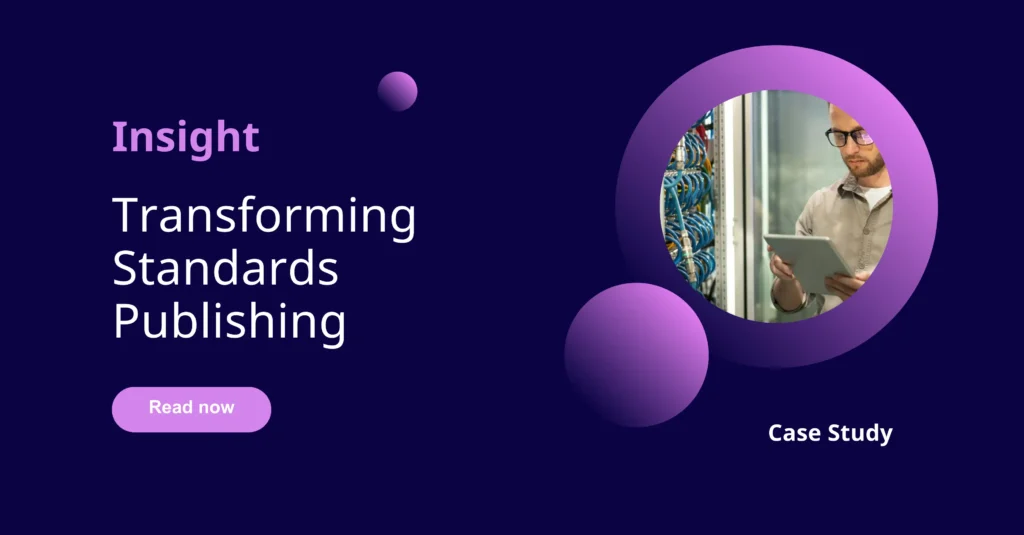Artificial intelligence (AI) is rapidly reshaping the landscape of publishing. Maintaining a trusted link between standards publishers and the end-users of the standards is more pressing than ever. The power of AI is leading to an internet that is increasingly awash with all sorts of texts that may – or may not – be accurate.
Standards Development Organizations (SDOs) play a crucial role in establishing the trustworthiness of digital materials as we advance – especially as we transition into a paperless environment where no ‘ground truth’ paper publication can be used to authenticate.
With standards source authentication technology, SDOs can protect the integrity of their standards and provide a vital new service to the organizations that rely on them.
Challenges in maintaining document authenticity and security
PDF standards are created and consumed using digital tools, making it difficult to track how this material is being operationalized. A significant amount of re-keying and/or copy/pasting is involved in managing how standards material finds its way into policies, procedures, CAD tools, software code, etc.
Although Digital Rights Management (DRM) tools add a layer of protection and security, the fact remains that the material ‘as used’ is not in the PDF it may have come from initially. Moreover, the most typically used parts of the standards – the requirements – are the parts most frequently copied/pasted.
Increasingly, tech-savvy consumers of standards are looking for ways to consume this information in smarter ways.
In an era when AI tools, adept at summarizing, will happily take a stab at extracting requirements from, say, PDFs or screenshots of text, how can standards users be confident in the results and what does this mean for standards developers’ intellectual property?
SDOs have a crucial role to play in establishing the trustworthiness of digital materials as we advance.
Ensuring visibility and trust in standards
- Ensure requirements/compliance information is consolidated and accessible in one place to SMEs
- Maintain audit trails of changes with dashboards/alerts
- Link to policy manuals and training materials to reduce the need for busy SMEs to have to read the standards themselves
The realities of how PDFs of standards are consumed via intermediating knowledge management applications result in the SDO’s brand power being diminished. Many subject matter experts (SMEs) may not even be aware of where individual requirements come from as their day-to-day interaction is with the internal knowledge library, PLM, or Requirements Management System.
Establishing trust in the authenticity of laws, regulations, and standards is crucial in today’s increasingly digital landscape. Thought leadership released by the World Economic Forum earlier this year calls for greater action and regulation on the creation of synthetic content. Some jurisdictions are moving towards digital authentication of their laws and regulations and SDOs need to be part of those initiatives.
The opportunity of knowledge graphs
Across industries, there is a clear trend toward the development of industry-specific taxonomies that seek to make content truly readable by machines. Examples include DISC standards being developed by the International Association of Oil and Gas Producers (IOGP) and the Digital Standards Alliance (DSA) for aviation/aerospace within SAE ITC.
Perhaps the most successful example of industry-specific taxonomy to date is the XBRL standard in audit and accounting. XBRL’s success hinges on the consensus approach to fine-grained naming of items relevant within auditing and accounting. For example, naming each line item on a company’s balance sheet and P&L statements. Although XBRL is XML and JSON under the hood, SMEs never need to work with it directly as it is produced/consumed automatically by Excel, accounting applications, regulatory filing systems, etc.
The AI revolution is ushering in a change in terminology as new and exciting techniques emerge that bake taxonomies into knowledge graphs. Knowledge graphs will be the dominant paradigm for machine readability of standards in the AI era.
AI also presents opportunities for SDOs to aid the authoring process, for example, increasing the efficiency of research processes, generating summaries, etc. SDOs can also tap into the benefits of a technology called Retrieval Augmented Generation (RAG) which, used in conjunction with Large Language Models (LLMs), can be used to ground the answers given by AI chatbots in reliable data and dramatically reduce the risk of hallucinations. Leveraging this technology will allow SDOs to develop new lines of business in creating AI assets for their customers by creating AI data products, AI knowledge graphs, and digital authentication services.

